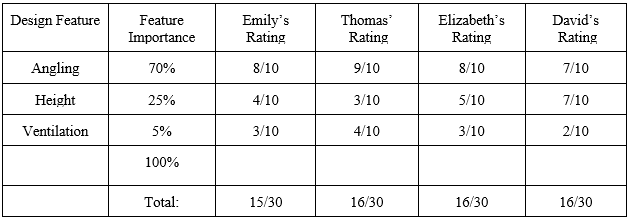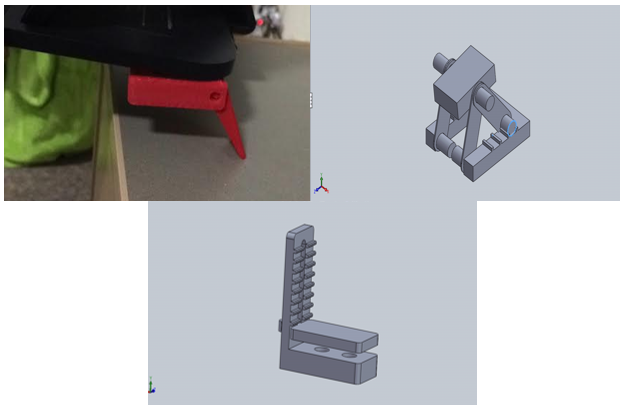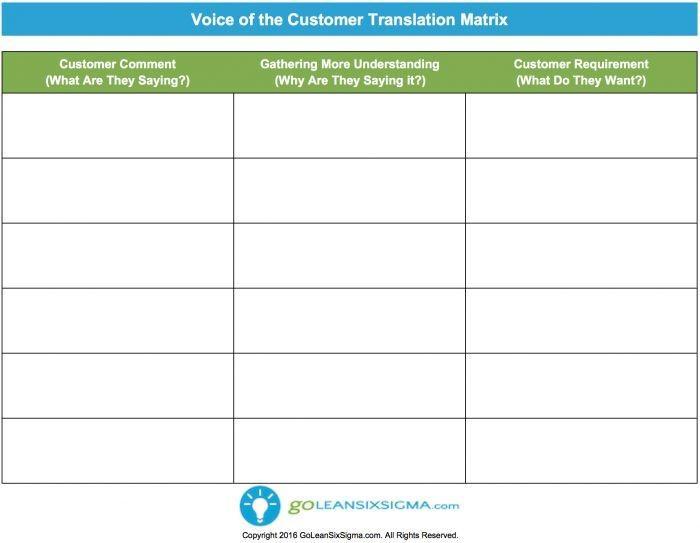A powerful tool in engineering product design as well as Information Technology is what is known as the Voice of Customer (VOC) assessment [5]. While there are many different tools associated with conducting a VOC assessment in industry (e.g., SurveyMonkey, interviews), the VOC assessment tools in general allow potential customers to identify what they want from your design.
While this concept did not originate in engineering design, the Voice of Customer assessment allows your team to turn qualitative feedback on aspects of your design into important design revisions. With respect to ethical design, it provides a qualitative and quantitative representation of how well your potential customers respond to your conceptual designs. Moreover, collecting feedback through VOC assessment respects customer autonomy by basing design decisions on what consumers want from your design solution.
Two tools useful tools that are used to conduct the VOC assessment that I find helpful are the VOC feature evaluation tool and the VOC translation matrix tool.
Voice of Customer Feature Evaluation Tool
The VOC feature assessment tool is used to determine what customers feel is the most important feature of your conceptual design solution and which of your conceptual designs would best fit consumer wants. Even though not all potential customers may feel the same about each feature in your conceptual designs, this tool allows each customer to rate each feature and provide a basis for narrowing down to the conceptual design that your team will produce.
Table 2 is an example of the VOC feature assessment tool as applied to a conceptual design for “Laptop Legs” from my MECH 10: Graphic Communications in Design course. The VOC feature assessment tool is a research method that requires you and your team to gain feedback from multiple potential customers. Customer feedback is essential in understanding how the design solution can be made more appropriate for future customers. In a Rights Approach perspective, understanding which elements your potential customers define as important will help your team choose the conceptual design ideas that would best respect your customers’ wants. Delivering a product that has been designed and iterated with ample input from the customer is part of respecting your customers’ right to receive a product that fulfills their expectations for safety and effectiveness.

Table 2: Laptop Legs Design Concept 1 Voice of Customer Feature Assessment. Courtesy of Rafael Guerrero, Hannah LeBlanc, Anthony Jackson, & L. Isaac Marcia, Santa Clara University ‘18

Figure 1: Conceptual designs 1, 2, & 3 for the “Laptop Legs” from the top left going clockwise, as part of the MECH 10: Graphic Communications in Design course.
Using the Voice of Customer Feature Evaluation Tool
- List out the features of your design. Make sure you can explain each feature and how it works in each conceptual design.
- Research features of competing/pre-existing design solutions.
- Choose a sample size of people who would use or want to use your product to interview (roughly 3-10 people).
- Consolidate a list of the features that are identified as important to your design. Ask a series of questions to determine which features are deemed most important. Rank these features and their importance using an estimated “feature importance” percent for each feature.
- Have potential customers one by one evaluate the conceptual designs your team has. Have each customer rank each concept’s rating for each feature importance out of 10 points.
- Sum up the individual ratings for each feature given by each customer to produce a score out of 10*n features.
- Conduct steps 1-6 for each conceptual design.
- Determine the conceptual design and desired features that your team will implement in your prototype/design iteration.
Personal Link
During the entrepreneurship section of the course, my design team used the VOC feature assessment tool to evaluate three different possible concepts for the prototype by focusing on three different features wanted by different students who would have wanted to purchase the Laptop Legs.
We created three possible designs for the Laptop Legs that targeted three main design features we felt were most important for our product: the angling of the laptop while in use, the height at which the laptop would be suspended from a surface while in use, and the increased ventilation of the laptop that the concept design would offer. As a team we then agreed upon a ranking of importance of each of the three features we identified in the form of a percentage. We then asked our potential customers to give a score out of 10 for how well each conceptual design met their expectations for each of the three design features we identified. After all three conceptual designs were evaluated, the concept that scored the most points among all categories was iterated upon and then fabricated for further field testing.
Voice of Customer Translation Matrix Tool
The VOC translation matrix is a less quantitative, more qualitative approach that engineers may use at the beginning of the design phase to better understand their customers’ wants. As simple as it may seem to ask questions to your customers and record their answers, what the customer says and what the engineer hears and understands may not be the same. It is important to not only ask good questions to your potential customer, but also to work within your team to identify the underlying issue and determine quantitative requirements that your design should aim to fulfill.

Figure 2: The Voice of Customer Translation Matrix Tool. Template is produced by Go Lean Six Sigma.
Using the Voice of Customer Translation Matrix Tool
The translation matrix template produced by Go Lean Six Sigma [6] in Figure 2 allows you to used to work your way from customer comments on your conceptual designs to a quantitative customer requirement that you and your team will aim to achieve with your design solution. What may be encountered in this process is that the customer is unable to express what they want, or they may not actually know what they want from your design.
Even if this is the case, it is as the saying goes: “the customer is always right”. This means that asking good questions that clarify what specific wants the customer has is as important as identifying the more technological requirements.
- Ask the customer to identify the problem or problems they wish to be solved. These are the collective inconveniences, pains, and risks associated with their daily work and/or life that a technological solution can be developed for.
- Ask the customer to identify what they would want out of a technological solution for their problem. Allow them to be creative, even unrealistic in their response-- often times, their comments suggest what pains they experience in dealing with their problem, and how they wish it can be eliminated.
- If their response is unclear, or it is not something easily quantifiable, ask how their current problem inconveniences them and what they feel could be done to ease or eliminate the problem. Record their comments with little to no paraphrasing, rephrasing, or rewording. Place these notes in the first column.
- For each comment, answer the question “Why are they saying this?” Use the notes you’ve taken or the customers themselves to help you understand what wants that they have that may be behind their comments. Place these notes in the second column.
- Additionally for each comment, answer the question “What do they mean by this?”. Try to restate their comments in a way that asks your team a qualitative question (restate “wearing the backpack hurts my back” or “the backpack is either too cumbersome or it doesn’t have good padding” to ask “what makes the backpack uncomfortable to carry?”).
- Turn the comments into a quantitative question. (e.g., “what material would work best for this backpack strap/padding?”; “how much of this material should be used to pad the back of the backpack?”; “how much should the product cost if we spend $X to put this material on the backpack?”; “how much is this potential customer willing to pay for a backpack?”).
References:
[5] Gaskin, Steven P, et al. Voice of the Customer. Massachusetts Institute of Technology Sloan Courseware, www.mit.edu/~hauser/Papers/Gaskin_Griffin_Hauser_et_al%20VOC%20Encyclopedia%202011.pdf.
[6] “Voice of the Customer (VOC) Translation Matrix - Template & Example.” Go Lean Six Sigma, Go Lean Six Sigma, goleansixsigma.com/voc-translation-matrix/.
